
http://www.iaeme.com/IJM/index.asp 119 editor@iaeme.com
International Journal of Management (IJM)
Volume 10, Issue 3, May-June 2019, pp.119-129, Article ID: IJM_10_03_012
Available online at http://www.iaeme.com/ijm/issues.asp?JType=IJM&VType=10&IType=3
Journal Impact Factor (2019): 9.6780 (Calculated by GISI) www.jifactor.com
ISSN Print: 0976-6502 and ISSN Online: 0976-6510
© IAEME Publication
DETERMINANTS OF TRUST AND CUSTOMER
LOYALTY ON C2C E-MARKETPLACE IN
INDONESIA
Widarto Rachbini, Iha Haryani Hatta
Postgraduate School, Faculty of Economics and Business,
Universitas Pancasila, Indonesia
Tiolina Evi
Department Accounting, Faculty of Economics and Business
Perbanas Institute, Indonesia
ABSTRACT
Stakeholders in C2C e-marketplace in order to optimize the category of groceries.
One way to do this is through customer equity management. Therefore, it is very
important to conduct research on the analysis of customer equity, customer loyalty in
the context of c2c e-marketplace in Indonesia (study in the product groceries category)
which aims to partially determine the effect of brand equity, value equity and
relationship equity on trust and customer loyalty and the influence of trust on customer
loyalty. The design of this study uses an explanatory approach. The data analysis
technique uses structural equation model (SEM) and sampling is limited to certain
criteria (purposive sampling). This study used 200 respondents. The results of this study
show that there is a partial influence of brand equity and value equity on constructs of
trust and customer loyalty. Meanwhile, relationship equity has a direct effect on trust,
but not on customer loyalty. Trust affects consumer loyalty. Companies must focus on
rewarding systems through cash back reward programs, virtual loyalty cards, incentive
programs, and virtual communities that have been proven to be able to increase
customer loyalty.
Keywords: Brand Equity, Value Equity, Relationship Equity, Trust, Customer
Loyalty.
Cite this Article: Widarto Rachbini, Iha Haryani Hatta and Tiolina Evi, Determinants
of Trust and Customer Loyalty on C2C E-Marketplace in Indonesia, International
Journal of Management, 10 (3), 2019, pp. 119-129.
http://www.iaeme.com/IJM/issues.asp?JType=IJM&VType=10&IType=3
1. INTRODUCTION
The emergence of internet and portable devices has an impact on C2C e-commerce which is
experiencing rapid development throughout the world (Dan, 2014). The internet has become a
part of life in everyday life that cannot be separated from modern human life since the

Widarto Rachbini, Iha Haryani Hatta and Tiolina Evi
http://www.iaeme.com/IJM/index.asp 120 editor@iaeme.com
commercialization of the internet in the mid-90s (Rachbini and Hatta, 2018). Currently there
are three players in the C2C e-marketplace category that have a balanced portion, namely
BukaLapak, Shopee, Tokopedia.
This should be a concern for stakeholders in the C2C e-marketplace in order to optimize the
daily food sub-category which is one of the basic needs of the Indonesian people. One way is
to manage customer assets more effectively through customer equity management. According
to Villanueva (2003), customer equity is looking at customers as the main source of cash-flows
now and in the future. Customer equity is able to have a positive impact on customer trust and
customer loyalty (Ramaseshan et al., 2013). So that companies build long-term relationships
with customers because the attachment leads to achieving higher profits (Kohlmeyer, 2016).
The customer equity concept combines brand management, relationship management,
retention management, and customer value management (Zhang et al., 2010). “Customer equity
is one of the main keys of marketing due to its ability to assess individuals, and customer
segments from a perspective” (Rust et al., 2000). By creating value for consumers, companies
in turn obtain value from consumers in the form of sales, profits, and customer equity in the
long run (Kotler and Armstrong, 2018). “Customer equity is formed on the basis of three main
dimensions, namely value equity, relationship equity, and brand equity” (Lemon et al., 2001).
To maximize the long-term performance of a company, a marketing manager needs to make
more responsible marketing investments by continuing to monitor these three things
(Ramaseshan et al., 2013).
Today more and more companies are shifting their focus to brand management towards
customer management. While customer equity can be a better measure of company
performance than current sales or market share. Companies must be able to manage customer
equity well, must see customers as assets that need to be managed and maximized (Kotler and
Armstrong, 2018). Vogel et al., (2008) and Johnson et al., (2006) revealed that customer equity
can encourage an increase in customer loyalty. Customer loyalty involves the intention to be
involved in future buying behavior with the same company or brand (Zhang et al., 2010).
Customer loyalty has a positive impact on profitability for a business/company (Ramaseshan et
al., 2013). Loyal customers have more long-term relationships with companies and are more
profitable because they are more easily served, able to pay higher prices, and recommend
products/services to new customers (Zhang et al., 2010). Meanwhile, Customer Loyalty is
highly related to trusts. Ramaseshan et al., (2013) revealed that customer trust plays an
important role in mediating customer equity and customer loyalty. Trust in a well-known brand
allows customers to feel security and reliability (Ballester and Aleman, 2001). Romaniuk and
Bogomolova, (2005) revealed that trust is considered an asset for a brand that can produce an
increase in customer loyalty.
Research topics related to customer equity have been extensively investigated and several
frameworks have been proposed and tested empirically (e.g. Bolton et al., 2004; Rust et al.,
2004; Vogel et al., 2008; Zhang et al., 2010; Ramaseshan et al., 2013). This study aims to
determine the partial effect of brand equity, value equity, and relationship equity on trust and
customer loyalty, and the effect of trust on customer loyalty.
2. LITERATURE REVIEW AND HYPOTHESES DEVELOPMENT
2.1. Customer Equity
According to Keller (2013), “the main objective of customer relationship management is to
produce high customer equity. Customer equity is the combination of total customer lifetime
values of all current customers and potential customers in the future”. The more loyal the
customer is to a company and provides many benefits, the higher the customer equity (Kotler
and Armstrong, 2018). “Customer equity is a combination of the value of the firm’s current and

Determinants of Trust and Customer Loyalty on C2C E-Marketplace in Indonesia
http://www.iaeme.com/IJM/index.asp 121 editor@iaeme.com
potential customer assets”(Hogan et al., 2002). Wirtz and Lovelock (2018) define customer
equity as customer lifetime values originating from a customer base in a company.
Customer equity identifies customer values and focuses on obtaining customer lifetime
value (Ramaseshan et al., 2013). Blattberg et al., (2001) revealed that there are two main reasons
why companies should use the customer equity approach. First, the development of new
technology makes customer asset-based management something feasible. Second, these
technological capabilities are accompanied by various changes in the way the market works in
the midst of an unstable business environment, making marketing must be managed well to
maximize the value of the customer assets of a company. Lemon et al., (2001) succeeded in
identifying three key drivers of customer equity, namely value equity, brand equity, and
relationship equity. The three key drivers are able to work partially or simultaneously in
increasing customer equity and the value of the firm.
2.2. Brand Equity
Strong brands have high brand equity. This is a measure of the brand’s ability to capture
consumer preferences and loyalty (Kotler and Armstrong, 2018). “Brand equity is the
customer’s subjective assessment of the brand and is more concerned with the image of a brand”
(Rust et al., 2000). “Consumers are more likely to know brands that have high reputation,
image, and strengthen consumer experience” (Pae et al., 2002). If a customer feels that a brand
is strong, unique, and desirable, then the customer feels high brand equity (Verhoef et al., 2007).
Brands are the best thing to build an image that makes customers able to identify a specific
thing compared to other things (Ramaseshan et al., 2013). Brand equity is a subjective and
intangible assessment perceived by customers of a brand (Lemon et al., 2001; Kim and
Brandon, 2010). Brands must be different, and must stand out in ways that are relevant to
consumer needs. Before consumers respond to brands, they must know and understand them
first. This must lead to positive consumer-brand connections (Kotler and Keller, 2016). Thus,
positive brand equity comes from consumers’ feelings about brands and connections with
brands. A brand with high brand equity is a very valuable asset (Kotler and Armstrong, 2018).
High brand equity gives the company a number of competitive advantages. Strong brands
have high brand awareness and customer loyalty. In addition, however, strong brands are
capable of forming customer engagement and customer relationships. The thing that underlies
brand equity is customer equity which is the value of customer relationships made by a brand.
A strong brand is important, but what it really represents is a group of loyal customers that
provides many benefits. The right focus of marketing is to build customer equity with brand
management that serves as the main marketing tool. In addition, company investment in brand
equity can increase customer trust which ultimately can influence customers’ price tolerance
for a brand (Delgado-Ballester et al., 2003).
2.3. Value Equity
In general, value is the key to customer relations with the company (Zhang et al., 2010). Value
equity is the objective assessment of customers about the usefulness of a brand based on
perceptions of what is given and what is received (Vogel et al., 2008). This can be understood
as a ratio in which things are perceived from what is received, and things that have been
sacrificed. In other words, “the perceived ratio between what is received (such as different
products and benefits) and what is sacrificed (such as the price paid for a product) and thus a
higher benefit cost ratio will result in higher value equity” (Ramaseshan et al., 2013). Value
equity refers to customer’s objective evaluation for the utility factor of a product or service
based on the perception of what is paid for what is received (Lemon et al., 2001).

Widarto Rachbini, Iha Haryani Hatta and Tiolina Evi
http://www.iaeme.com/IJM/index.asp 122 editor@iaeme.com
In addition, the three key drivers that influence value equity are quality, price, and
convenience (Lemon et al., 2001). Value equity becomes important when there are significant
differences with competing products (Ramaseshan et al., 2013). Investments are made on value
equity, so they can create higher trusts that can change customer behavior because trust is one
of the most important factors in maintaining long-term relationships (Ryssel et al., 2004).
Value is the fundamental customer relationship with the company. The best brand
marketing strategy or relationship marketing will not be enough if the company's products and
or services do not meet customer needs and expectations (Ramaseshan et al., 2013). Rust et al.
(2004) succeeded in proving that value equity is able to increase customers’ loyalty intentions.
Meanwhile, Vogel et al. (2008) in his study showed a direct relationship between value equity
and customer loyalty. “Value equity affects loyalty, both directly and indirectly through trust
as a mediator of the relationship” (Ramaseshan et al., 2013). Molinari et al., (2008) found that
“perceived value is one of the key factors in getting actual repurchase which is part of customer
loyalty”.
2.4. Relationship Equity
The tendency of customers to maintain the brand from objective and subjective judgment of the
brand. The four key drivers of relationship equity are loyalty programs, special recognition and
treatment programs, community building programs, and knowledge development programs
(Keller, 2013). Relationship equity is the tendency of customers to stick around using a brand
regardless of their subjective and objective judgment on the brand (Lemon et al., 2001).
Relationship equity focuses on switching costs that bind customers and companies, based
on actions taken by companies and customers to build and create relationships. Relationship
programs can be implemented in various ways. One example, when companies provide
additional benefits for customers to move, reward programs and strengthen customer
relationships through emotional ties. Relationship equity is very important when the benefits
obtained by customers through loyalty programs are greater than the actual benefits obtained
(Aravindakshan et al., 2004). In addition, trust in previous studies conducted by Ramaseshan et
al., (2013) acts as full mediators for relationship equity and customer loyalty relationships.
2.5. Trust
Transactions in C2C e-marketplaces operate platforms used to communicate and complete
transactions (Wei et al., 2018). Trust plays an important role in electronic trading transactions
(e-commerce) when there is a perceived high risk (Gefen et al., 2003). In a C2C environment
e-marketplace, buyers and sellers do not know each other so it is difficult to develop emotional
ties during the transaction (Wei et al., 2018). Trusts are often identified in interpersonal buyers-
sellers, namely interpersonal trust (Chang et al., 2013). Trust can be interpreted as customer
confidence in certain brands that can satisfy customer desires (Rachbini, 2018).
Trust can be seen as a social construct which then develops into two dimensions, namely
cognitive and affective aspects (Johnson and Grayson, 2005). “Cognitive trust is a rational view
that can be explained as the willingness of the buyer to depend on the competence and reliability
of the service provider company”. Furthermore, affective trust is an emotional view that can be
assessed as a perception of buyer actions that are intrinsically able to motivate others to remain
in a relationship (Ramaseshan, 2013).
Trust is a key factor to make customers loyal (Kohlmeyer, 2016). Trusts induce repeat
purchases made by customers based on evidence of a company’s reliability in providing
expected value over time (Sirdeshmukh et al., 2002). Previous research conducted by Singh and
Sirdeshmukh, (2000) proved empirically that “there is a positive impact of trust on customer

Determinants of Trust and Customer Loyalty on C2C E-Marketplace in Indonesia
http://www.iaeme.com/IJM/index.asp 123 editor@iaeme.com
loyalty, and even trust is considered more important than satisfaction in forming loyal customer
base” (Ranaweera and Prabhu, 2003).
2.6. Customer Loyalty
Today, many companies focus on customer relationship management which aims to manage
customer information and customer touch points to maximize customer loyalty (Kotler and
Armstrong, 2018). Customer loyalty is an attachment or deep commitment from buyers to
repurchase a product, service, brand, or organization in the future, even though there are
situational influences and marketing efforts that have the potential to trigger switching behavior
(Oliver, 1999). Ludin and Cheng, (2014) describe customer loyalty as a continuous relationship
between customers and brands. Customers can develop a strong sense of loyalty to the brand,
as reflected in retention, repurchase, and finally recommending the brand (Kotler et al., 2017).
Kotler et al., (2017) also revealed that in pre-connectivity era, loyalty is often defined only
as retention and repurchase. Tabaku and Zerellari, (2015) revealed that there are two approaches
to customer loyalty, namely behavioral and attitudinal. The behavioral approach in customer
loyalty refers to the consistency of customers and the sustainability of purchases, while the
attitudinal approach is the psychological connection of customers with products or services that
involve preferences and components such as positive attitudes and commitment.
Companies can learn customer loyalty by analyzing loyalty patterns in a market. This can
be started from studying the company's loyal customers. Customers who have high loyalty are
real assets. They can promote brands through personal word of mouth, as well as social media.
A person can be loyal to brands, stores, and also companies. Buyers can be classified according
to their level of loyalty (Kotler and Armstrong, 2018).
Thus, referring to the number of descriptions above related to customer equity, trust, and
customer loyalty, the following are some of the hypotheses that can be formulated in this study:
H1 : Brand equity has a positive effect on trust
H2 : Value equity has a positive effect on trust
H3 : Relationship equity has a positive effect on trust
H4 : Brand equity has a positive effect on customer loyalty
H5 : Value equity has a positive effect on customer loyalty
H6 : Relationship equity has a positive effect on customer loyalty
H7 : Trust has a positive effect on customer loyalty
3. RESEARCH METHODOLOGY
3.1. Research Design
The design of this research uses an explanatory approach. Through explanatory studies it is
expected to be able to find out how the influence between two, three, or more constructs and
patterns, directions, and strengths on each of these influences (Leedy and Ormrod, 2005).
3.2. Data Collection
The method of data collection in this study uses a non-probability sampling approach. Non-
probability sampling is more reliable than other approaches and can provide some important
clues to getting potential information and relating to the population (Sekaran and Bougie, 2016).
In this research, the researchers used purposive sampling as an approach to collect data in the
field.
Sampling of this type is limited to certain types or individuals who can provide the desired
information, either because of the one who owns it, or in accordance with the specified criteria.


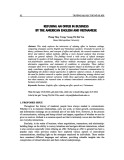
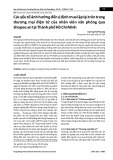
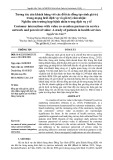
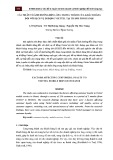
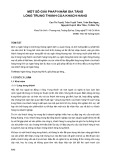
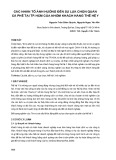

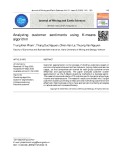


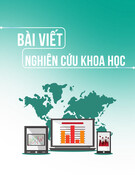
![Đề thi kết thúc học phần môn Truyền thông trong kinh doanh [năm học mới nhất]](https://cdn.tailieu.vn/images/document/thumbnail/2025/20251015/dilysstran/135x160/93281760499390.jpg)


![Bài tập nhóm truyền thông marketing tích hợp [mới nhất]](https://cdn.tailieu.vn/images/document/thumbnail/2025/20250904/hakanami1502@gmail.com/135x160/90671756969236.jpg)





![Định vị doanh nghiệp: Bài thuyết trình [Mới nhất]](https://cdn.tailieu.vn/images/document/thumbnail/2025/20250813/vuthuhuyen1407/135x160/6261755072381.jpg)



